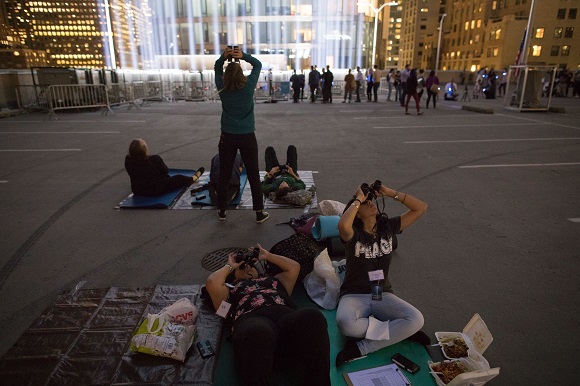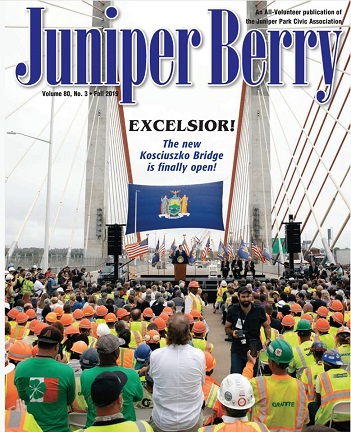Even in a city of skyscrapers, the Tribute in Light is colossal: twin columns of blue-white light shining four miles high into the bruised orange-black bowl of the night sky. With clear weather in New York City, the beams are crisply visible from 60 miles away. Illuminated every September 11 since 2002, the Tribute is an iconic and emotional memorial to the lives lost in the 9/11 terrorist attacks and a symbol of New York City’s unbreakable spirit. It is a beacon in more ways than one. Birds are drawn to the lights, at times by the thousands. On September 11th, 2017, I was drawn to the lights by the birds.
At sunset, I join a small gathering of people on top of a six-story parking garage near Wall Street. At the entrance to the upper deck, I pass the event production staff supervising the display, conferring over a bevy of laptops and switchboards. To the eastern side of the roof, rescue workers and families of the victims of 9/11 congregate near a long white tent over a dinner buffet. Opposite, to the west, New York City Audubon staff and volunteers gather. Dominating the roof are the spotlights: 88 in total, separated into two square arrays to the north and south, twenty parking spaces apart. As lighting technicians check their snaking cables, the beams wink with dust motes and the looping flight of insects. There are few vertical light installations in North America of the magnitude of the Tribute. Only the Luxor Sky Beam in Las Vegas, Nevada, compares. I crane my head back, looking for birds, but quickly drop my gaze, dizzy. From afar, the Tribute is a powerful spectacle. Standing below the beams, it’s staggering.
I cross the roof to join Susan Elbin, director of conservation and science for NYC Audubon, as she greets her volunteers. In coordination with the National September 11 Memorial & Museum, NYC Audubon maintains an annual presence monitoring the Tribute to ensure that the beauty of the memorial does not compromise the safe passage of nocturnally migrating birds.
Over the last century and a half, scientists have catalogued the detrimental effects to nocturnally migrating birds from manmade light sources, from lighthouses to communication towers, and the ever-growing sprawl of city skyglow. When the Tribute was first proposed, NYC Audubon anticipated similar problems of attraction, aggregation, and possible collisions in the night sky over lower Manhattan. By 11 p.m., most of the rescue workers here for the memorial leave the site, but the Tribute stays illuminated all night long. New York City is south of the boreal forest. If weather conditions are right, millions of birds could be moving regionally in mid-September throughout the night.
NYC Audubon started communication with city officials in 2002 and negotiated access to the site, a distinction already granted to the families of those lost in the terrorist attacks. But it was not until 2005 that a partnership arose, with the production team agreeing to turn off lights if need be. In 2007, NYC Audubon proposed the official protocol: If one or more birds crashes to the ground, dead; if the birds appear to be trapped (flying low in the beams and calling); or, if 1,000 birds are in the beams for more than a 20-minute period; then the lights are shut off for 20 minutes, to allow them to fly on.
By 8 P.M., the silhouettes of birds flash, uplit, as they thread through the spotlights’ beams. A Chimney Swift flies in low with shallow, stiff wingbeats. A Northern Flicker shoots by, its wings outstretched in a brilliant revelation of yellow. While the birds are familiar, their behavior is strange. They seem to be caught in a gyre, looping the blue-white lights.
Near the parapet wall, Andrew Farnsworth, a research associate at the Cornell Lab of Ornithology, adjusts the tripods of two cameras a meter apart. Both cameras are pointed straight up, a laptop between them. The monitor displays a pair of grainy images of birds circling in the beams. With basic trigonometry, Farnsworth can calculate the altitude of the birds as their flight slows and descends under the influence of the Tribute.
Elbin, Farnsworth, and other Cornell Lab-affiliated researchers gathered data and observations from the Tribute in Light from 2008 to 2016, and after analysis, published their findings in the Proceedings of the National Academy of Sciences in 2017. In seven nights over the nine years of study (two years were omitted due to poor weather), the lights were shut off 22 times. With each episode of temporary darkness, the birds’ behavior—including circling at decreased speeds and lower altitudes, and increased vocalization and aggregation at the lights—stopped within minutes.
At 8:30 P.M., there are 400 birds wheeling a few hundred feet above us. Of the 102 species recorded at the Tribute, the majority are Neotropical migrant songbirds, each only the weight of a couple of coins. Many are young birds that just hatched the previous summer, embarking on their first southbound migration and particularly susceptible to the draw of skyglow.
I raise my binoculars and look north, where the floor-to-ceiling windows of a new residential building reflect 60-plus stories of pure white light. As I scan, a Blackburnian Warbler strikes the glass at 30 stories up, its wings spread wide. It falters, then flies straight back into the spotlights and continues circling the beams. Farnsworth grimaces.
By 10:45 p.m., the count of birds in the beams is over a thousand. The quantity of birds visible above us is staggering, but radar confirms that many more are flying our way. If the weather on September 11 is favorable for migration, the regional influence of the Tribute is tremendous, drawing in densities of migrating birds at 20 times (and up to 150 times) their normal levels. In seven nights of study over seven non-consecutive years of the Tribute in Light, the scientists estimate that 1.1 million birds were influenced by the beams.
With the bird density count in hand from her volunteers, Elbin walks off to find the production staff. It’s time to turn out the lights.
Just past midnight, with the lights illuminated once again, more birds appear in the beams. One of the volunteers recruited by Farnsworth, birder Anders Peltomaa, seeks out Elbin. Peltomaa is holding a dead male American Redstart—jet black, with a white belly and vivid orange patches on its wings, sides and tail. The bird is small enough to fit neatly into his open palm. Disoriented by the lights, the bird must have struck a building. Its neck appears to be broken.
Elbin takes the dead redstart gently, her jaw set, and strides away to find the light production staff, corpse in hand. Typically, a shutdown takes 15 minutes to negotiate. This time, it takes five.
“I just opened up my hand,” Elbin says, “I just took the bird and held it out. ‘Oh my God,’ [they] said, ‘Turn the lights out.’”
The American Redstart is the first mortality of the night, and only the second bird ever found dead by NYC Audubon monitors at the Tribute. But it’s difficult to calculate the actual number of bird deaths due to the lights. At the Tribute and throughout downtown Manhattan, bird carcasses from collisions are often scooped up by building custodians or devoured by animal scavengers such as rats before they can be discovered in the morning light.
Building collisions claim an estimated 90,000 birds a year in New York City. A study by scientists at the Smithsonian Migratory Bird Center estimated that nearly 600 million birds die every year in the United States due to building collisions. The low number of bird fatalities at the Tribute speaks to the dedication of all stakeholders and the powerful impact of turning off the lights, allowing the birds to fly on.
During the 20 minutes of darkness after the lights are shut off, the pixelation on the radar above Lower Manhattan disappears. High up, further than we can see from the roof deck, the birds have dissipated, southbound again.
As new pulses of birds migrate overhead, the lights are snuffed out four more times throughout the night. At last, in the hours toward dawn, the night seems calmer, emptier. I check the radar again. The blue and green pattern is now gray, indicating slower-moving biota: insects. Throughout the night, wisps of smoke coil off the spotlights as hundreds of insects, charmed by the lights, strike them repeatedly. Scattered around the arrays are the burnt bodies of stinkbugs and wasps, beetles and mantises, moths and flies. On the half-hour, Graham Montgomery, an entomologist from Cornell recruited by Farnsworth, discreetly collects them into neatly labeled vials. By dawn, Montgomery will find insects from around 40 families in 10 orders. A warmer night would have encouraged the movement of tens of thousands of insects.
At sunrise, Great Black-backed and Ring-billed Gulls arrive on the roof to pick through the insects barbecued on the lights. Elbin takes her leave, shaking hands with the event staff and small group of rescue workers who stayed through the night. The Tribute is a necessary and beautiful memorial. The opportunity to study nocturnal bird migration here, and the gravity of this night, is not lost on the scientists.
Earlier in the day, before joining Farnsworth at the Tribute, Cornell Lab researcher Kyle Horton had visited the World Trade Memorial Site for the first time, a somber visit that made a big impression on the 29-year-old.
“The Tribute in Light is an important icon, a symbol of remembrance,” he says. “The fact that organizers are willing to turn the lights off for migratory birds is encouraging for conservation.”
Farnsworth echoes that sentiment: “There’s another intention with this site, deep and profound. That will always color the science of what we’re doing. We’re lucky to have people who are thoughtful enough, caring enough, to let us do this.”
Annie Novak writes about the connections between people, agriculture, and ecology for The Atlantic and Organic Life magazine. She is currently working on a book about the scientific study of nocturnal bird migration. This article originally appeared in Living Bird magazine and has been reprinted with permission.




